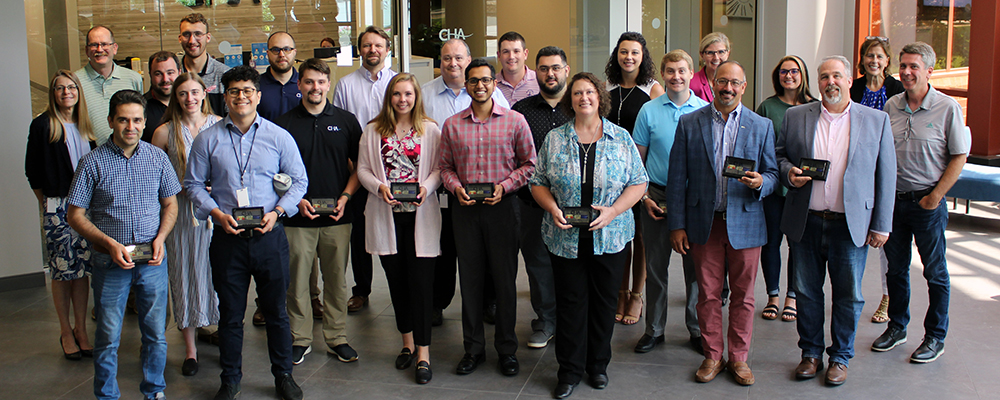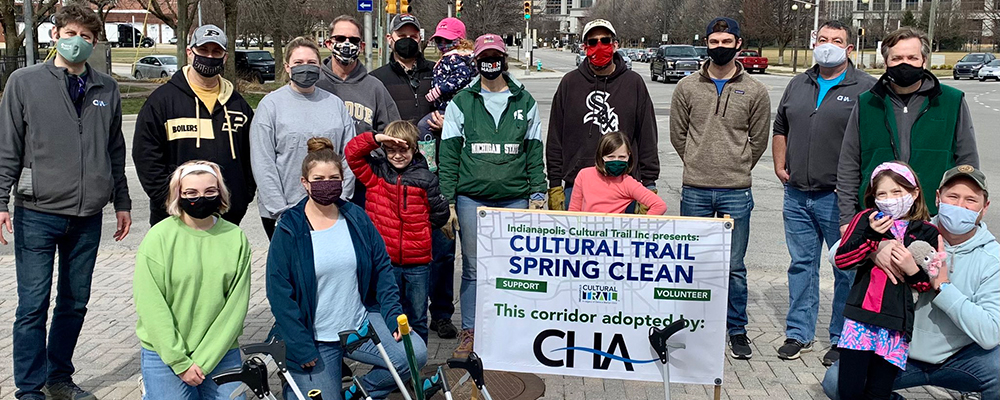Creating a Culture of Sustainability: The Role of Green Teams
Posted June 5, 2023
Celebrate World Environment Day by discovering how a Green Team can help your organization develop and achieve its sustainability goals. CHA’s Green Team is at the forefront of this effort, as our biggest impact on creating a more sustainable world is through the projects we partner on with clients. We have a comprehensive sustainability initiative that rests on four strategic pillars, and the Green Team guides our progress in achieving the goals we have set:
- Sustainable Services & Clients – We provide sustainable practices in the services we offer to help our clients plan, design, and build projects that endure.
- Sustainable Workforce – We inspire our employees by creating an environment that connects us to our company and communities and challenges our employees to grow personally and professionally.
- Sustainable Communities – We meaningfully engage with stakeholders and support the communities in which we work and live.
- Sustainable Operations – We measure our environmental footprint and implement programs to reduce resource use, waste and carbon emissions.
You will find valuable insights and examples to help you decide whether a Green Team is the right fit for your organization. Let’s work together to responsibly improve the world we live in.
What is a Green Team?
Green Teams are essential to an organization’s development and implementation of a comprehensive sustainability initiative. Comprised of passionate employees who volunteer their time and expertise, these teams develop short- and long-term goals and actionable solutions to improve the sustainability of an organization’s operations, products, and services. They focus on the organization’s business strategy, operations, culture, and shared communities.
CHA’s Green Team exemplifies the positive impact Green Teams can make. Since January 2020, the team’s dedicated members, totaling over 35 colleagues, have set measurable sustainability goals, tracked progress, and implemented programs to reduce our environmental footprint, strengthen our impact in our communities, and create an inclusive culture. The team guides our annual sustainability report, which we have issued since our inaugural 2019 report. The Green Team’s initiatives have helped CHA achieve remarkable progress, including the realization of its carbon reduction goal two years early.
Here are some advantages of Green Teams in helping companies achieve their sustainability goals and drive positive change:
Sustainable Services & Clients

As an engineering design, consulting and construction management firm, we know our biggest impact on creating a more sustainable world is through the projects we have the privilege of working on with our clients. For our public and private clients, there is an intentional evolution to more sustainable solutions as it relates to our commercial and institutional, power and manufacturing, and infrastructure sectors. They need cleaner, greener, and more renewable energy supplies, transportation and mobility systems, and buildings. The sustainability shift is not in just one sector but across the entire economy. There’s an acceleration of the energy transition and electrification toward clean energy, driving utilities to modernize the grid and accelerating the acceptance of alternative energy sources. There’s also unprecedented federal funding from the IIJA and IRA exerting pressure to deploy projects more quickly and increasing the need for design/build and alternative project delivery. These are very exciting challenges for engineers – designing and overseeing the construction of resilient infrastructure, buildings that minimize environmental impact and enhance human well-being, and more efficient and renewable energy solutions. It’s what we do … every day.
CHA’s Green Team members are experts in their fields and can look around the corner when it comes to market trends and opportunities – this is extremely important as we partner with our clients to address their challenges.
Creating Sustainable Operations

Companies today are called upon to do their part in reducing their environmental footprint. To minimize the environmental impact of their operations, companies need to adopt a suite of practices. One of the primary responsibilities of a Green Team is to establish the baseline environmental footprint of the organization, identify ways to reduce that footprint, and set short- and long-term reduction goals.
Green Procurement Policy
Green Teams can play a significant role in developing and implementing a green procurement policy that prioritizes purchasing and using environmentally friendly products, oversee policy implementation, track purchases, collect data, and make recommendations.
Companies can reduce their environmental footprint by adopting a green procurement policy. CHA’s Green Procurement Policy, which the Green Team developed, covers the purchase and lease of computers, laptops and printers; paper; and vehicles. Our policy is directed at purchasing products that help us achieve our emission reduction goals and use paper that is more environmentally friendly.
Waste Reduction and Recycling
Waste reduction and recycling practices are crucial in reducing the amount of waste generated by organizations. Green Teams can work with office supply partners to ensure that sustainable products are included in product catalogs. Additionally, employees can be encouraged to bring their own cups, plates, and utensils for office use to decrease or eliminate single-use products. Water and energy conservation measures can be cost-effectively designed and implemented, including filtration water stations, faucets and lighting operated by sensors. Recycling programs can be enhanced or instituted to divert waste from landfills so the content can be reused or repurposed.
Green Meetings and Travel
In-person meetings help drive business performance and growth. Like most professional services companies, CHA’s indirect carbon emissions, including emissions associated with business travel and energy use, are our largest. Our Green Team has identified a host of opportunities to green our business travel and meetings to help reduce emissions, including flying direct routes, bundling business travel, and empowering our employees with information about hotels, airlines, car rental companies, and restaurants that offer more sustainable products and services or incorporate sustainable practices in their operations. The Green Team has also developed recommendations for sustainable meeting practices, such as using digital invitations and avoiding single-use products. Green Teams can help ensure sustainability is incorporated into business meetings, events, corporate outings, tradeshows, and giveaways. Promoting carpooling and mass transit incentive programs can help reduce the number of single-occupancy vehicles on the road, reducing greenhouse gas emissions. Furthermore, the use of electronic collaboration tools, such as video conferencing and online project management systems, reduces the need for transit in the first place, reducing not only associated carbon emissions but also the amount of time and money spent on travel. CHA has integrated many of these practices and seen positive results.
Carbon Reduction Strategies
Carbon emissions are a significant contributor to climate change, necessitating the implementation of carbon reduction strategies to minimize environmental and societal risks. Green Teams can lead in developing these strategies, including carbon accounting and reporting practices, setting carbon reduction goals, and monitoring progress in meeting goals. CHA, for instance, used the carbon dioxide (CO2) equivalent per employee as a metric to track its progress toward a 20% reduction goal by 2025 from the baseline set in its 2019 Sustainability Report. Through various carbon reduction initiatives implemented since 2020, CHA achieved a 19% reduction in its CO2 equivalent per employee by the end of 2022. The remaining 1% was attained through investment in carbon offsets upon the recommendation of CHA’s Green Team. Reaching this milestone demonstrates the impact of such actions in measuring and ultimately reducing an organization’s carbon footprint.
Sustainability Reporting
To keep everyone informed and engaged, it is vital to report on progress. With the help of a Green Team, an annual sustainability report can be developed that highlights the organization’s achievements, goals, and plans for the future. By sharing this report with clients, employees, and other stakeholders, organizations can showcase their commitment to improving the environment and holding themselves accountable for their sustainability efforts. For an example of a comprehensive report, we invite you to read CHA’s 2021 Sustainability Report. Check back for CHA’s 2022 Sustainability Report, scheduled to be released later this month.
Creating a Sustainable Workforce

Building a sustainable workforce requires creating an environment that encourages personal and professional growth, strengthens community connections, and challenges employees to develop their skills continually. Companies can achieve this by implementing programs and initiatives that focus on attracting and retaining talent, employee engagement, growth and development, recognition and rewards, and supporting the next generation of STEM leaders.
Green Teams can promote sustainable workforce practices that help employees balance their personal and professional lives while reducing carbon emissions from commuting as a bonus. They can advocate for implementing flexible work schedules, providing reasonable accommodations for work locations, and fostering interpersonal connections through programs like the DISC Assessment.
If a company has an Inclusion and Diversity (I&D) Council, a Green Team can collaborate to promote diversity, equity, and inclusion in recruitment and internal promotions and also offer unconscious bias training. CHA’s Green Team and I&D Council frequently work together on these initiatives, providing regular progress updates to the organization as a united front. By investing in these programs and initiatives, companies can retain talented employees who share their mission and values.
Creating Sustainable Communities

Sustainable communities prioritize the well-being of their residents by striving to create a healthy environment, promote social equity, and drive economic prosperity. Green Teams help companies contribute to these communities. These teams can connect companies to the areas where their employees and clients live and work by coordinating employee volunteerism and outreach activities focused on education, environment, health, and wellness. These initiatives help create a sense of community within the organization while building positive relationships with community partners.
CHA’s Green Team is advancing the company’s efforts to contribute to sustainable communities by focusing our employee volunteerism, corporate giving, and community outreach in three strategic areas:
- Education – Focusing on science, technology, engineering, arts, and math (STEAM)
- Environment – Focusing on efforts to improve our natural resources
- Health & Wellness – Focusing on improving the health and wellness of our communities and people
A Green Team can play a crucial role in putting focus on employee volunteerism, corporate giving, and outreach activities to benefit communities in meaningful ways.
Responsibly Improving the World We Live In

Green Teams can help design and implement an organization’s sustainability initiative. Consisting of colleagues from throughout the company organizationally and geographically who are highly collaborative, the Green Team is one of the key determinants of a successful sustainability initiative. A Green Team is evergreen, working in perpetuity to embed sustainability into all aspects of the organization. We encourage you to establish your own Green Team and join us in responsibly improving the world we live in.
CHA recognizes the responsibility of creating a sustainable world and will continue to raise the bar. For businesses looking to engage in sustainability efforts, CHA’s expert colleagues are available to help. Contact them at sustainability@chasolutions.com to learn more.

Erin Crotty
Senior Vice President,
National Market Director
“With decades of experience in the public sector, CHA understands the many stakeholders and complexity of navigating public authorities, federal and state agencies, and municipalities of all sizes. We bring great insight and solutions to the evolving challenges our governments are facing.”